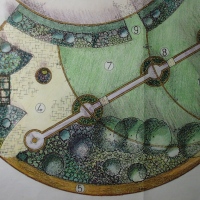
Scylla- ‘4 weeks late’ in 2013
‘Everything’s four weeks late’. So said my friends and fellow gardeners Derek and Mary Manning in April last year (we were just emerging from the coldest winter in 50 years). This was when I wrote this last article in the series on gardening and climate change.
You might remember Mary from my first article in the series. She’s the Norfolk gardener who’s been keeping records of when certain plants first flower each year – for over 60 years in fact.
Over that time she’s seen a gradual creeping forward of when some spring flowers do their stuff, so supporting the evidence from elsewhere that the overall climate is warming in the UK and that Spring is starting earlier…. Yes, you did read correctly, spring is starting earlier! That is until 2013, when all the expectations flew out of the window as we had our coldest March for 50 years and, as any UK gardener will tell you, most plants were holding off until the real Spring arrived. The Manning’s evidence in 2013 showed that Scylla (the lovely purply- blue woodland bulb) flowered on the 4th April in 2013, almost exactly a month later than in 2012!
Why do I share this information with you? Well, if you’ve been reading my previous articles in this series you will have gathered that recent events in the UK’s weather (and further afield) seem to be prompting some rethinking of the theories and forecasts of climate change and it’s expected effects.
In my first article, I set out what the forecasts currently are and how these seem to be changing, so that unexpected or abnormal weather events (prolonged periods of unseasonal cold,wet or drought) seem to be increasing in their frequency and impact on gardeners – and everyone else. This could mean that we need to set aside notions of ‘lateness’ in flowers blooming or not, as the age-old certainties of what and when the different seasons happen is changing.
How can we gardeners cope with this increased unpredictability? My second article talked about how we can prepare the garden for this sort of uncertainty – how to create our own, managed ‘micro climate’ if you like. In my last article I talked about how this preparedness needs to be complemented by a watchful, vigilant gardener – I call him/her the ‘Constant Gardener’. A way of gardening which is tuned in to what’s happening in the short to medium term and can take remedial action to further ameliorate or take advantage of the weather we get.
This article is the final piece of the jigsaw, so to speak – what sources of information and intelligence are already open to us and that may possibly develop in the future? In short, how to ensure that as well as being well prepared, watchful and diligent we take advantage of all the information we can to better judge what we do and when in the garden. I want to cover the following topics:
-
Weather forecasting – can we expect longer range forecasting to improve, to give us the forward view we need of how particular seasons are going to go?
-
Plant hardiness and quality – are there any systems for judging and ranking plants to help us?
-
Pests and diseases – what early warning systems are there to help us prevent the worst effects of these in our gardens as the seasons roll on?

Weather – can we expect seasonal forecasting to improve?
Back in April 2013 here in Norfolk we were forecast (I nearly said ‘promised’) rain over night on two occasions. This failed to materialise so I had to adjust my plant moving plans a little and the continuing dry weather meant I could get on with other weather dependent tasks in the garden. I have to say, I wasn’t that surprised as here in eastern England the progress of easterly tracking weather fronts can often promise rain, only for this to peter out over the rest of the country before we see any benefit. This day to day uncertainty is to be expected and to be honest I can probably live with it, as the weather forecasts, including their useful ‘severe weather warnings’, are generally reliable enough.
If I were overly anxious or wanting to plan things on almost an hour by hour basis the Met office’s ‘Nowcasts’ use radar to look a few hours ahead. Particularly useful for those harvesting waste water on an agricultural scale as well as extreme weather events involving potentially damaging hail, strong winds and lightning, I could look these up and plan my activities to the minutest degree. What I really would value though, is a longer term picture of what the next few months or weeks are likely to hold weatherwise. Not surprisingly, it’s this sort of forecasting that proves to be the most challenging as it involves monitoring and then predicting a number of variables and is particularly difficult in the UK because of our position on the globe. As the Met office explains:
‘Our one-day weather forecasts are right six days out of seven, and today’s four-day forecasts are as accurate as one-day forecasts were 30 years ago. While this shows great advances in reliability, we cannot always predict detailed differences in weather at a local level.
This is because the atmosphere is an extremely complicated system, affected by a huge number of factors and with the potential to react in endless different ways. To ensure completely accurate forecasts at all times, we would have to greatly increase the amount of observations we get so they cover every part of the planet, every minute of the day. Even then, a supercomputer far more powerful than anything in existence today would be needed to simultaneously process all this information into forecasts.
We are not there yet, but as we increase the number of observations, the complexity of the models, and the power of our supercomputers, forecasts should get more and more accurate.’
-

Online Weather services hold a wide range of information including ‘outlooks’ for the month and season aheadOf course it doesn’t help matters when the media gets hold of these longer term forecasts and makes simplistic and crude statements like ‘scorching summer predicted’ and so on.
This just discredits the longer term forecasting with all its hedging around with probabilities, if’s and but’s. The Met Office defended it’s work on long-range forecasting following criticism of its forecasts for the Spring and summer of 2012, when exceptionally wet weather hit the UK.
It concluded:‘We are confident that long-range outlooks will improve progressively and that the successes we have achieved in other parts of the world already will, in the future be mirrored in the UK. The Met Office constantly reviews the accuracy of our forecasts across all time scales and is recognised by the World Meteorological Organization as one of the top two national weather forecasting services in the world….Better understanding and representing the drivers of predictability in the global climate system that influence our weather patterns is as ever a priority for Met Office research in order to deliver improved advice and services on all timescales.’
Further comment came in a reply to my specific questions about longer range forecasting and gardeners. Dave Britton of the Met Office said:
‘The provision of longer-range forecasts is extremely challenging and always will be for the likes of NW Europe and the UK, where only small changes in driving factors can have a big influence on pressure patterns, wind direction and therefore our weather. However the science of longer range forecasting is improving and just as we have seen huge improvements over the last 40 years or so in the provision of 3 to 5 day forecasts, we will see similar advances in long-range forecasting in the future too.’
The position in North America appears to be somewhat more predictable, though even here there have been exceptional weather events in recent years which may point to a more uncertain future. The larger-scale, continental climate here seems to make it easier to predict things like first and last frost days in different parts of the US and Canada, something that the Met Office doesn’t do, mainly because the weather in the UK is much more variable.
So, apart from hoping that longer range forecasting will improve what other weather data can the UK gardener use to inform his timings and techniques? For fruit and veg growers a critical factor is air and soil temperature for germination and planting. Maybe we need to be even more aware of what’s needed for different types of plant- see the examples of this sort of information below.

Temperatures required for germination of different seeds

Days for different crops to germinate at different temperatures

Temperatures for planting different crops
Plant hardiness and quality – what systems are there to help us choose plants that perform and are resilient?
Another area of information we gardeners can use to cope with weather relates to plants themselves – their hardiness, resilience to particular extreme conditions and other qualities. In the UK the Royal Horticultural Society has reviewed both its plant hardiness and ‘Award of Garden Merit’ systems. The new plant hardiness system is now temperature based (instead of classifying the UK into four geographical hardiness zones which was the basis of the previous system).
Now plants are being put into seven categories from glasshouse plants (H1) through to plants which are ‘fully hardy’ (H7). The RHS Director of Horticulture, Jim Gardiner says he is conscious that in the UK plants have to contend with other factors than temperature when looking at ‘hardiness’ – the condition of the plant itself, prevailing climatic conditions, growing conditions, position in the garden, age, provenance and so on. We also have temperature swings to contend with (RHS – ‘The Garden’, February 2013). So I guess there is a recognition that this hardiness guide (which is currently limited to the plants in the RHS Award of Garden Merit scheme) has its limitations.
But, as Jim Gardiner says, it is a system which is plant, not place – based (like the US Department of Agriculture Winter Hardiness Zone approach – see the map below). So, it is perhaps more useful for the UK gardener, where our maritime context and variations in temperature and associated growing conditions can be much more localised (as well as increasingly unpredictable) than is the case in such a large continental land mass.
-
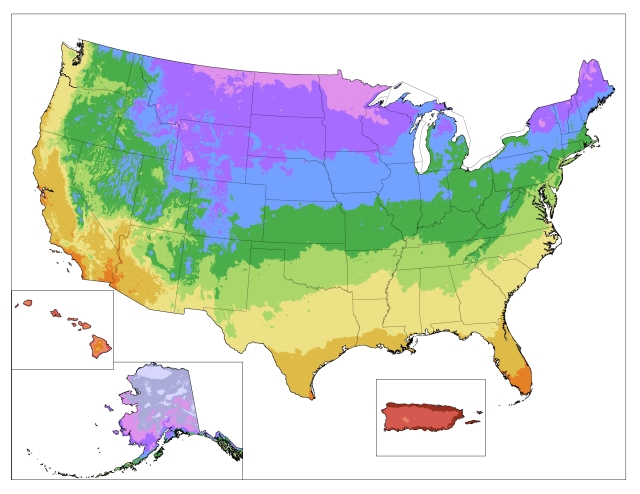
USA Winter Hardiness Zones
- USA Winter Hardiness Zones
The other main plant rating system in the UK – the ‘Award of Garden Merit’ – is also run by the Royal Horticultural Society, and began in 1922. It received a complete overhaul in 1992 and a ten yearly review cycle resulted in a new list being compiled last year. In addition, following plant trials or round table reviews by plant committees and specialists, new awards are made every year. The ten – yearly reviews ensure that every variety is still available, hasn’t developed disease or pest problems, and hasn’t been superseded by something better. In the 2012 review, for example, the crab apple ‘Comtessa de Paris’ replaced ‘Golden Hornet’, which can suffer scab. In the 2012 review of the nearly 1000 vegetables holding the AGM, 404 were no longer available, so they have been deleted from the list.
The AGM is intended to be of practical value to the home gardener and is awarded only to a plant that meets the following criteria:
-
Excellent for ordinary use in appropriate conditions – a cultivar or selection that outperforms others, perhaps for more flowers, length of flowering, scent, colour, form etc.
-
Available to buy
-
Of good constitution – the plant should be known to be generally healthy
-
Essentially stable in form and colour – it should perform according to its description
-
Reasonably resistant to pests and diseases – it should have no pest and disease issues that would affect growth and performance
-
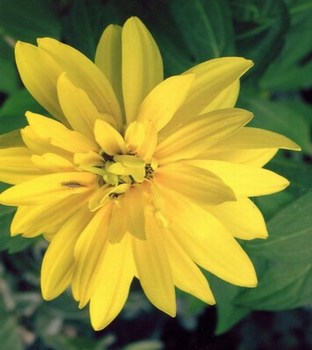
Rudbekia laciniata ‘Goldkugel’- in the RHS AGM list and considered to be fully hardy (H7)
-
Rudbekia laciniata ‘Goldkugel’- in the RHS AGM list and considered to be fully hardy (H7)
Just because a plant has an AGM, does not mean it will do well when poorly looked after. A large number of plants hold AGMs at any one time. The current list (which includes the plant hardiness rating) contains over 6000 ‘ornamentals’ and 1000 ‘fruit and vegetable’ varieties and is used in plant gazeteers such as the RHS ‘Plant Finder’ which lists where plants, including AGM holders, can be purchased. A similar system operates in the US, the ‘All American Selection’ (AAS), which is slightly younger and somewhat different to the AGM. The judges and the trial grounds vary from year to year and four categories are judged: Flower, Bedding Plant, Vegetable, Cool Season Bedding Plant, and only never-before-sold varieties are tested.
So, the new and updated systems of plant hardiness and quality look like being useful sources of information for gardeners considering which new plants (or maybe replacements) to grow in their particular location and with an eye on future weather extremes. And it is no accident that some experts are starting to identify plants that can withstand particular climatic extremes, like flooding.
-

Potato blight- there have been early warnings of its spread for 8 years in the UK
Pests and diseases – can we get early warning of possible problems?
Finally, it is clear that some (if not many) pests and diseases can flourish in different weather conditions. Is it possible to predict how different pests or diseases might affect your garden so that you can take the necessary preventative action? In the UK there are some useful ‘early warning systems’ especially for food growers. For example there is a system for potato blight, which is prone to develop in damp, warm conditions. The Potato Council has offered a blight incident reporting service for 8 years. This information is collected on a voluntary basis by 300 ‘blight scouts’ drawn from members of the potato industry who are routinely walking potato fields during the season. You can sign up to be alerted about blight with the Potato Council.
-
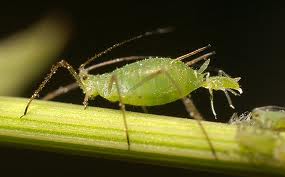
You can sign up for early warnings of the spread of aphids
-
You can sign up for early warnings of the spread of aphids
The UK Horticulture Development Company Pest Bulletin provides early warnings of potentially damaging pest attacks and valuable advice for planning this season’s planting of fruit and veg. Providing information throughout the key periods of pest activity, the HDC Pest Bulletins are updated on a regular basis, especially when particular insects are developing rapidly.The HDC also produces a Pest blog.
The UK Home Grown Cereals Authority (HGCA) also produces a weekly regional ‘aphid alert’ which you can sign up to. All these systems have their value, but I’m not aware of any system that draws them together for gardeners on a regular, regional basis. Perhaps this is something the RHS might coordinate, incorporating the latest weather forecasts and advice about particular issues affecting different plants?
To sum up, there are already a number of sources of information and intelligence available to the gardener that can help ensure a successful garden. Some of these – e.g. longer term weather forecasting and pest and disease warnings – would clearly benefit from further investment and coordination. These can be put alongside measures to prepare your garden for unpredictable weather and adopting an approach to gardening which is ‘watchful and diligent’- the constant gardener. It will also be interesting to see the results of the RHS- University of Reading survey of gardeners and climate change models when it is published- hopefully sometime in April 2014.
Together they give me optimism that the gardener of the future will be well equipped to cope with climate change. And we mustn’t forget the importance of adopting sustainable gardening practices as well as a positive move to reduce the ongoing impact we have on global warming and its fuelling of further climate change.
-

One way of monitoring water levels?!
-
One way of monitoring water levels?!
If you have any comments on these ideas or have some of your own, I’d love to hear from you!
Previous articles in this series:
Further information:
Old School Gardener
If you’ve enjoyed reading this post and others on this blog, why not comment and join others by signing up for automatic updates via email (see side bar, above right ) or through an RSS feed (see top of page)?
 9. Critter care
9. Critter care




















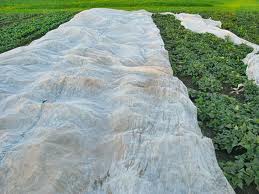



 Previous articles in this series:
Previous articles in this series:










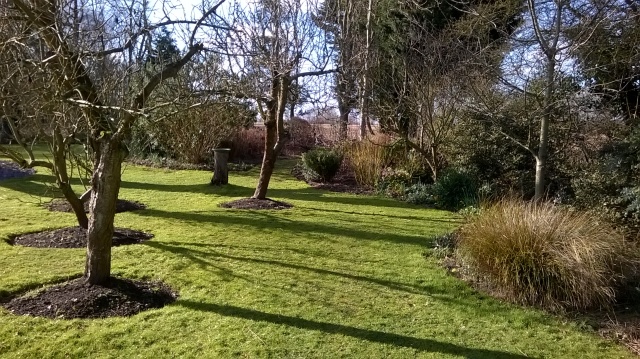 Old School Garden – 29th February 2016
Old School Garden – 29th February 2016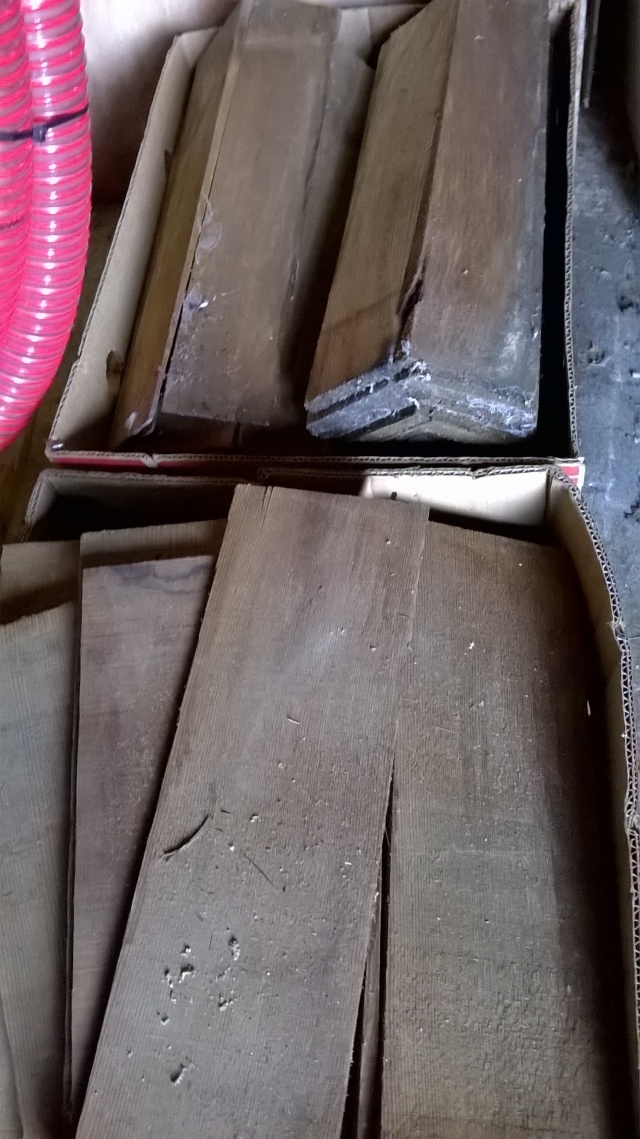





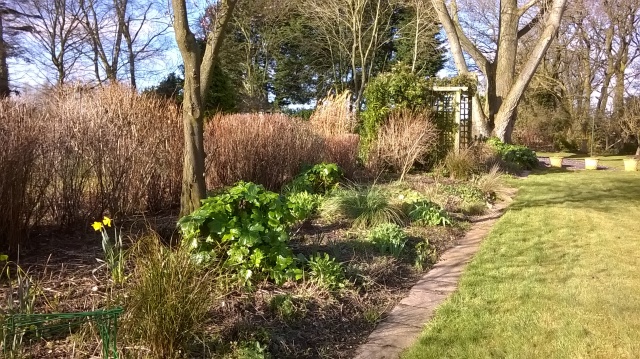





























 Well, as we come to the end of another year, I’m grateful that the garden here seems to have survived pretty well, despite less attention than normal; but the ground elder awaits and this and the other weeds will need attention in a couple of months time before the growing season really gets underway!
Well, as we come to the end of another year, I’m grateful that the garden here seems to have survived pretty well, despite less attention than normal; but the ground elder awaits and this and the other weeds will need attention in a couple of months time before the growing season really gets underway! 
